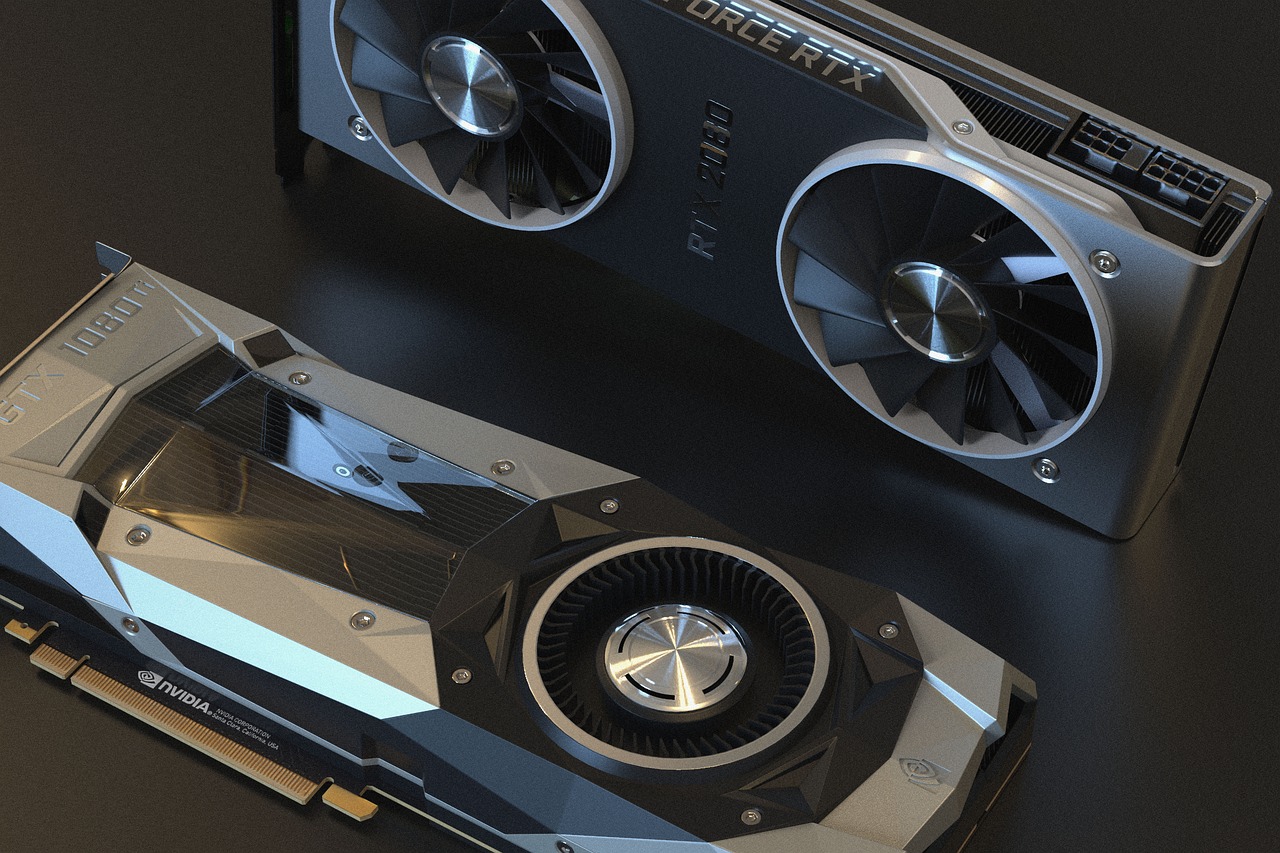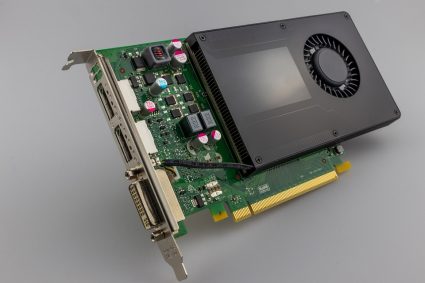
A graphics card is a specialized piece of hardware that processes and produces images to be displayed on a computer monitor. It is sometimes referred to as a video card or GPU (graphics processing unit). The graphics card is an important component in any laptop, as it is responsible for displaying high-quality images and videos. Graphics cards are available in a variety of types, from basic models for basic computing tasks to more advanced models for gaming and video editing.
Content of the page
What is a Graphics Card?
A graphics card consists of two main components: a graphics processing unit (GPU) and video memory. The GPU is responsible for processing images, while the video memory stores the graphics information. The graphics card also connects to the computer’s motherboard and processor, allowing the graphics card to communicate with the system. The graphics card is responsible for rendering images on the computer screen.
Types of Graphics Card
Graphics cards are available in a variety of types, each designed for different types of computing tasks. The most common types of graphics cards include:
- Integrated Graphics: Integrated graphics cards are the most basic type of graphics cards and are built into the computer’s motherboard. These cards are suitable for basic computing tasks such as word processing and web browsing, but are not suitable for gaming or advanced video editing.
- Discrete Graphics: Discrete graphics cards are more powerful than integrated graphics cards and are designed for gaming and video editing. These cards are installed separately from the computer’s motherboard and require additional power from the power supply unit. Discrete graphics cards can provide better performance than integrated graphics cards, but require more power and cooling.
- High-end Graphics: High-end graphics cards are designed for gaming and video editing and provide the best performance available. These cards are more expensive than other types of graphics cards and require a more powerful power supply and cooling system.
Integrated Graphics vs. Dedicated Graphics
Integrated graphics are built into the computer’s motherboard and are suitable for basic computing tasks such as word processing and web browsing. Dedicated graphics cards, on the other hand, are installed separately from the computer’s motherboard and are more powerful than integrated graphics cards. Dedicated graphics cards are suitable for gaming and video editing and provide better performance than integrated graphics cards.
Importance of Graphics Card in Laptops
Laptops are becoming increasingly popular for gaming and video editing, and the graphics card is an important component of a laptop. A good graphics card is necessary for gaming and video editing, as it will provide better performance than an integrated graphics card. A good graphics card will also help reduce the amount of heat generated by the laptop, which is important for long gaming sessions. The graphics card is also responsible for displaying high-resolution images and videos, which is important for gaming and video editing.
How to Choose a Graphics Card for Your Laptop?

When choosing a graphics card for your laptop, there are a few important factors to consider. First, you should consider your budget. Graphics cards range in price from budget models to high-end models, so you should decide how much you are willing to spend on a graphics card. Next, you should consider the compatibility of the graphics card with other components in your laptop. Finally, you should consider your performance requirements. If you are a casual gamer, a budget model may be sufficient, but for more demanding tasks such as video editing, a more powerful graphics card may be necessary.
Budget Considerations
When choosing a graphics card for your laptop, it is important to consider your budget. Graphics cards range in price from budget models to high-end models, so you should decide how much you are willing to spend on a graphics card. Budget models are suitable for basic computing tasks, while more expensive models are suitable for more demanding tasks such as gaming and video editing.
Compatibility with Other Components
It is also important to consider the compatibility of the graphics card with other components in your laptop. Most graphics cards require additional power from the power supply unit, so you should make sure that the power supply unit is compatible with the graphics card. Additionally, some graphics cards require additional cooling, so you should make sure that the laptop has enough cooling for the graphics card.
Performance Requirements
Finally, you should consider your performance requirements. If you are a casual gamer, a budget model may be sufficient, but for more demanding tasks such as video editing, a more powerful graphics card may be necessary. It is also important to consider the type of games you will be playing, as some games require more powerful graphics cards than others.
Benefits of Having a Dedicated Graphics Card in a Laptop
Improved Gaming Experience
A dedicated graphics card in a laptop can be a great boon for gamers, as it can significantly improve the gaming experience. The main benefit of having a dedicated graphics card is that it can provide better performance and higher frame rates. This is especially important for games that require a lot of graphics processing power, such as first-person shooters or real-time strategy games. With a dedicated graphics card, gamers can enjoy smoother gameplay, better visuals, and higher resolutions.
Better Video Editing Performance
For those who are into video editing, a dedicated graphics card can be a great asset. A dedicated graphics card can provide better performance when it comes to editing high-resolution videos and creating complex effects. This can be especially beneficial for those who are working with 4K and 8K videos, as the graphics card can handle the increased processing power required for these types of videos.
Higher Productivity for Professionals
For professionals in the creative industry, having a dedicated graphics card can be a great benefit. This is especially true for those who rely on programs such as Photoshop, Illustrator, and other creative software. A dedicated graphics card can provide better performance when it comes to tasks such as image processing, 3D rendering, and video editing. Having a dedicated graphics card in your laptop can help increase your productivity and reduce the amount of time it takes to complete certain tasks.
Disadvantages of Having a Dedicated Graphics Card in a Laptop
Higher Cost
The main disadvantage of having a dedicated graphics card in a laptop is the cost. Dedicated graphics cards are generally more expensive than integrated graphics cards, so having one in your laptop will add to the overall cost of the device.
Increased Power Consumption
Dedicated graphics cards also consume more power than integrated graphics cards, which means that you will have to pay more for electricity if you have one in your laptop. This can be especially problematic if you plan on using the laptop for extended periods of time, as the additional power consumption can quickly add up.
Additional Weight and Size
Finally, having a dedicated graphics card in your laptop can also add to the overall size and weight of the device. This can be a problem if you plan on using the laptop on the go, as it may be too bulky or heavy to carry around.
| Pros | Cons |
|---|---|
| Improved visual performance and graphics quality | Increased power consumption and heat generation |
| Ability to run graphically intensive applications/games | Higher cost compared to integrated graphics |
| Ability to handle multiple displays | May require additional power supply or cooling system |
| Support for advanced graphics APIs (such as DirectX) | May require additional driver updates or maintenance |
| Option to upgrade or replace for improved performance | May not be necessary for basic computing needs |
How to Install a Graphics Card in Your Laptop?
Installing a graphics card in a laptop is a great way to improve your laptop’s performance and get the most out of its graphics capabilities. While it may seem like an intimidating task, it is actually quite simple if you know what you’re doing. In this article, we’ll walk you through the steps necessary to install a graphics card in your laptop.
Precautions Before Installation
Before you begin the installation process, it’s important to take some precautions to ensure your laptop remains safe. First, make sure you have the appropriate tools for the job, such as a Phillips head screwdriver and a small flathead screwdriver. Additionally, make sure you have a secure, flat work surface to work on and a good source of light.
It’s also important to remember to disconnect all power sources to the laptop before beginning. This includes the battery and any adapters or cables that may be connected.
Step-by-Step Guide to Installing a Graphics Card in a Laptop
Once you have taken the necessary precautions, it’s time to begin the installation process. Here is a step-by-step guide to installing a graphics card in a laptop:
- Remove the laptop’s back panel. This will usually involve unscrewing several screws, so make sure you have the appropriate tools on hand.
- Disconnect the battery from the laptop. This is important for safety and should always be done before beginning any kind of repair or installation.
- Remove the existing graphics card, if there is one. This will involve unscrewing some screws and disconnecting any cables that may be attached.
- Install the new graphics card. This will involve lining up the graphics card with the motherboard and inserting it into the correct slot. Secure the card with the screws and reconnect any cables that may be required.
- Reattach the laptop’s back panel and reconnect the battery. Make sure all screws are tightened securely.
- Turn on the laptop and install the necessary drivers for the new graphics card.
Common Installation Issues and How to Solve Them
If you’re having trouble installing your graphics card, here are some common issues and their solutions:
- The laptop won’t turn on: Make sure all power sources are connected securely and that the battery is inserted correctly. If the laptop still won’t turn on, you may need to replace the battery.
- The driver won’t install: Make sure you are using the correct driver for your graphics card. If you are, try downloading the driver again and reinstalling it.
- The laptop won’t recognize the graphics card: Make sure the card is securely connected to the motherboard and that all screws are tightened. You may also need to reset the BIOS to detect the graphics card.
Conclusion
Installing a graphics card in a laptop is a great way to improve its performance and get the most out of its graphics capabilities. While it may seem like an intimidating task, it is actually quite simple if you know what you’re doing. Just remember to take the necessary precautions beforehand and follow the steps outlined in this article.
Summary of Key Points
- Make sure you have the appropriate tools and a secure, flat work surface to work on before beginning.
- Disconnect all power sources to the laptop before beginning the installation process.
- Follow the steps outlined in this article to install the graphics card in your laptop.
- Make sure the card is securely connected to the motherboard and that all screws are tightened.
- If you’re having trouble installing your graphics card, make sure you are using the correct driver and that all power sources are connected securely.
Final Recommendations
Installing a graphics card in a laptop is a great way to improve its performance and get the most out of its graphics capabilities. Just make sure you take the necessary precautions beforehand and follow the steps outlined in this article. If you have any trouble, make sure you are using the correct driver and that all power sources are connected securely.
